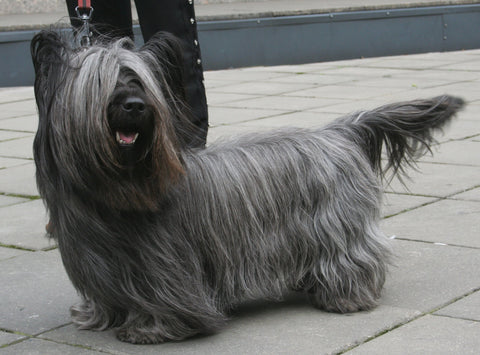
Skye Terrier
Quick Facts:
- AKC recognized in 1887
- Lifespan: 12 to 14 years
- Size: Small
- Energy: Medium
- Recommended Crate Size: 24” dog crate*
Return to main Dog Crate Size Breed Chart.
Introduction
The Skye Terrier is a hunting dog that prefers to explore safe areas. The Skye is well suited to living indoors, enjoying life as a house pet.
The purest of this dog breed were found on the Isle of Skye in Scotland, thus the name Skye Terrier. This Scottish dog breed was first described in the 16th century when they were already noteworthy for their long coat.
Some confusion exists in tracing its history because, for a certain time, several different breeds had the same name "Skye Terrier".
The loyal dog, present under the petticoat of Mary, Queen of Scots at her execution, has been ascribed as a Skye Terrier.
In 1840, Queen Victoria made the breed fancy, keeping both drop-(floppy) and prick-(upwards) eared dogs in her care. This popularity came with it when the Skye Terrier came to America.
Once the AKC recognized the Skye in 1887, it quickly appeared on the show scene. Its popularity has steadily declined over the years to the point that this unique dog breed is one of the least known terriers, with little awareness of its former popularity.
Breed
The American Kennel Club formally recognized the Skye terrier in 1887. These medium energy dogs are known as a vermin-buster in a fancy coat.
However, the Skye is more than that. The Skye is self-assured and fearless, but he's also happy, friendly, and devoted to its people. The Skye Terrier seems to believe in a give-and-take relationship.
If he's given an affection, respect, and the attention he needs, he will give the same back to his owner.
Appearance
The standard height for a Skye Terrier is 10 inches (male) and 9.5 inches (female), and it weighs between 25 - 40 pounds.
The Skye has a double coat, with a hard, straight outer coat with a soft and short undercoat. The shorter hair of the head veils his eyes and forehead, creating a moderate beard.
This breed has well-feathered ears and the hair usually falls like a fringe (in prick-eared), accenting the form and blending with the side locks. It can have fawn, blonde, blue, light or dark grey, and black fur with black points (ears and muzzle).
Except for the ears' size and shape, there is no significant difference found between the prick- and drop-eared varieties. In prick-type, the ears are medium-sized, carried high on the skull and angled slightly outwards.
Nutrition
It is recommended to provide feed formulated to small-sized breeds. It is highly recommended to discuss your dog’s feed with your veterinarian and/or breeder in order to determine the size and frequency of meals in order to ensure a healthy, long life. It is also important to ensure that clean, fresh water is always available.
Grooming
Give a regular combing (twice a week) to keep the Skye looking healthy and well. It is recommended to not bathe this breed too often as it will soften the coat too much.
However, owners should give their attention to the area around their mouth and eyes because frequent cleaning is needed for this area. Give it a bath every two to three weeks.
Weekly brushing with a long-toothed comb or a pin brush is needed. Be sure to comb or brush out any tangles before bathing the dog. Once they get wet, they tighten up and are more difficult to remove. If you're brushing a dry dog, mist the coat with water as you brush to prevent hair breakage.
Other grooming needs include nail care and dental hygiene. Teeth-brushing is needed at least two or three times a week to remove tartar buildup and bacteria. Nail trimming is done once or twice a month, as needed.
Short nails keep the feet in good condition and won't scratch your legs when your Skye jumps up to greet you. It also prevents painful nail cracking when its nails become too long.
Exercise
The Skye does not need a large amount of exercise, but it should be regular and moderate. If the young Skye (especially under 8 months) is over-exercised, their bone growth will be damaged, leading to a painful limp and possibly badly bowed legs.
Jumping up and down from high objects, climbing over objects, rigorous running, even overly long walks, are all things to be avoided for the first 8 to 10 months to prevent later problems and allow for correct closure of the growth plate.
The Skye is sensitive but responds well to a firm voice and positive-reinforcement techniques that involve praise, food rewards, and play. Although the Skye has a medium level of activity and is an indoor-type, they still require daily exercise.
Plan for at least 30 minutes of exercise each day. The Skye will enjoy a daily walk or active play in the yard. He will become unhappy and bored without regular exercise and training, which can invariably lead to destructive or noisy behaviors.
Pet Crate Size
Pet Crates Direct recommends 24” dog crates* for most adult Skye Terriers.
* Links for crate sizes will bring you to the most appropriate Amazon page.



